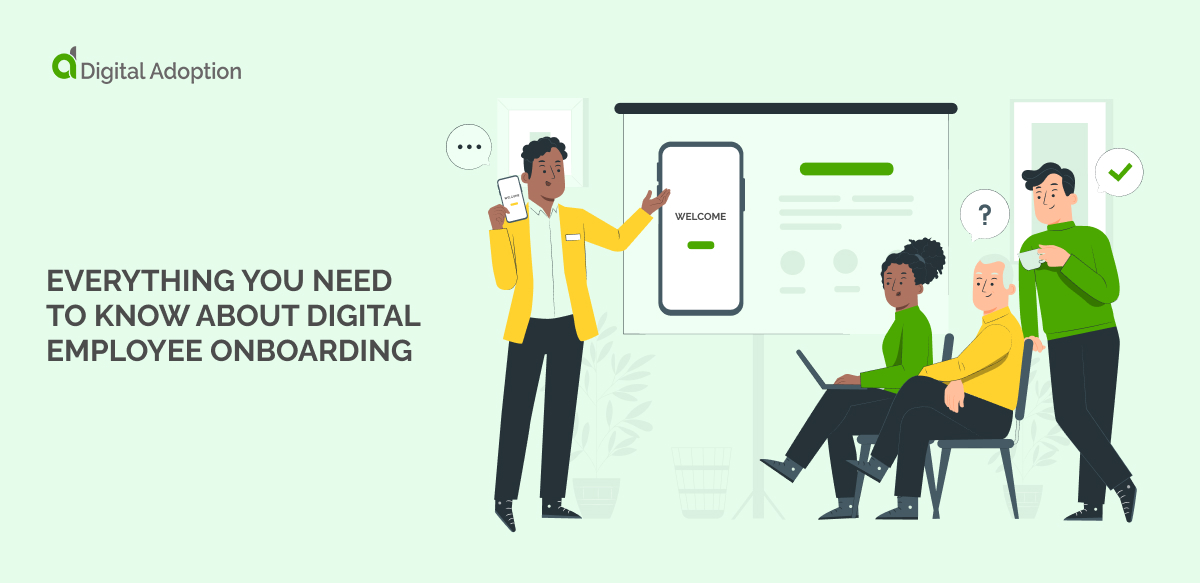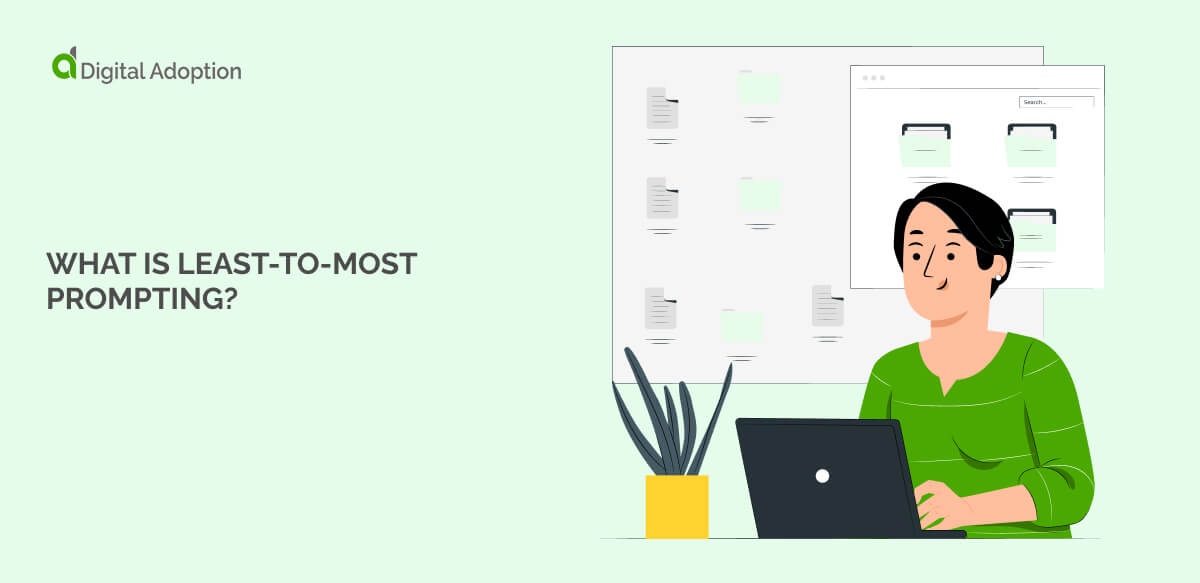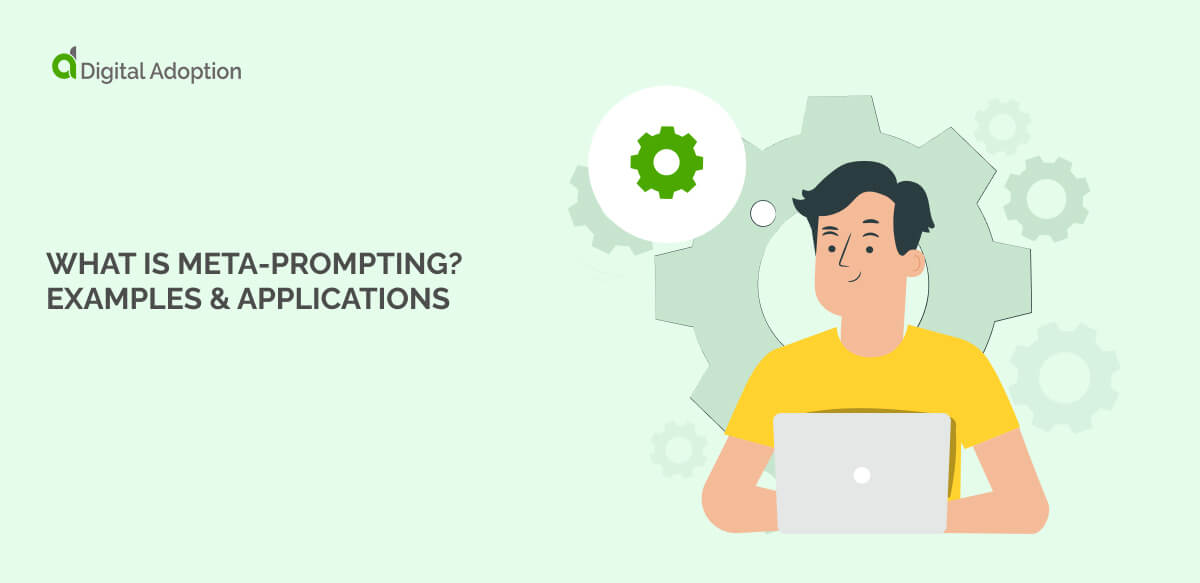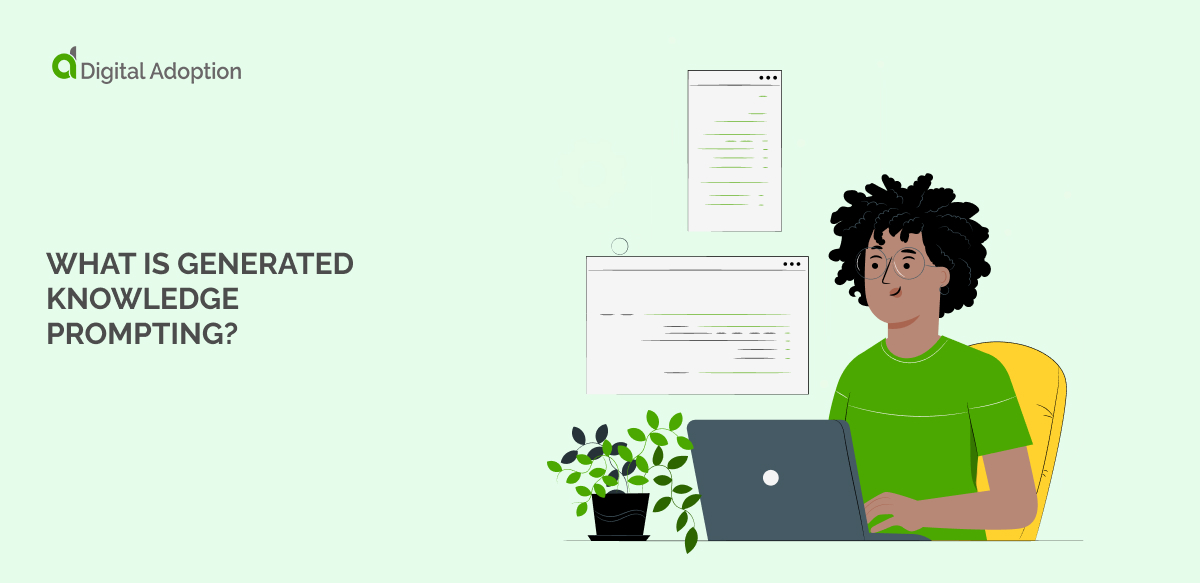The digital onboarding process is a little like the first few dates; you only get one chance to make a good first impression.
Whether onboarding goes well or not, it will likely define a new employee’s relationship with your business.
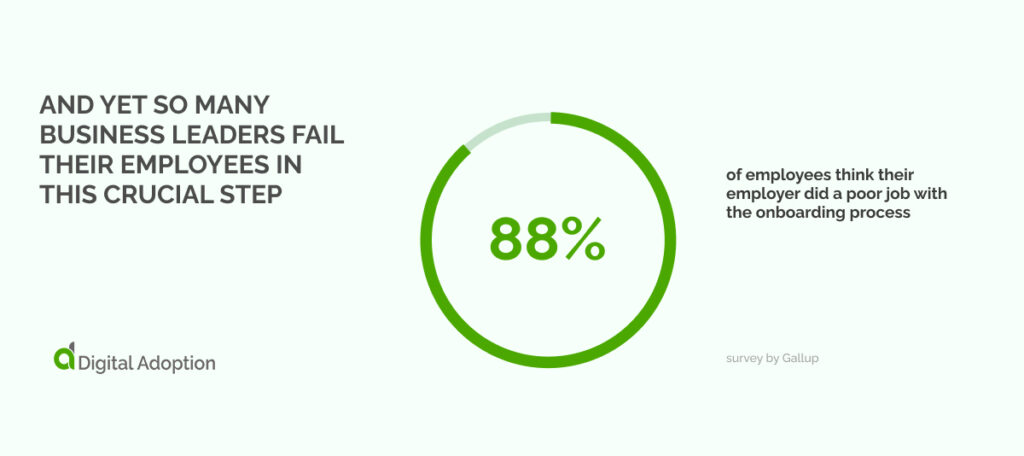
And yet so many business leaders fail their employees in this crucial step. According to a survey by Gallup, 88% of employees think their employer did a poor job with the onboarding process.
What is it that so many employers are doing wrong?
Why are employers more important than ever to deliver excellent onboarding experiences to new employees?
How can you use digital technology to fine-tune your onboarding process?
We’re going to answer all these questions and more. By the end of this article, you’ll
- Know everything you need to know about digital employee onboarding.
- Learn how to use digital transformation to perfect the onboarding process.
- Discover how digital adoption technology can help you train new and existing employees to boost performance, efficiency, and engagement.
We’ll review the basics of digital employee onboarding and the benefits of getting it right. We’ll also give you some practical tips on creating an engaging digital employee onboarding process.
- What is Digital Employee Onboarding?
- Creating The Digital Employee Onboarding Process: Whose Job is it?
- Why is Digital Onboarding Important in The Digital Age?
- Benefits of Digital Employee Onboarding
- Deliver the Perfect Onboarding Process with the 4 C’s of Onboarding
- 5 Practical Tips for Delivering Excellent Digital Onboarding
- Digital Employee Onboarding: The Key to a Long and Fruitful Tenure
What is Digital Employee Onboarding?
Digital onboarding is introducing new hires to your organization while using digital technology to create an immersive experience.
It goes beyond a simple orientation or job training program; it’s about giving employees access to all the resources they need to thrive in their new roles.
Digital employee onboarding should include everything from setting up accounts and providing access to important files to answering questions about the company culture, programs, processes, and expectations.
The goal is to make the transition from outside candidate to full-fledged team member seamless and painless for both employee and employer.
Where digital employee onboarding differs from traditional employee onboarding is that digital tools facilitate every step of the process. Employees can be anywhere worldwide and receive a consistent onboarding experience.
This is critical for businesses operating remotely or large corporations with multiple branches.
Digital onboarding is also an essential part of digital transformation. It’s a way to bring your onboarding process into the digital age, using the latest technologies and tools to create an engaging, effective learning experience.
Last but certainly not least, it’s a great opportunity for employers to show that they care about their employees by providing an efficient onboarding process and ensuring they can access the best tools and resources available.
New employees want to be useful as soon as possible and feel like they can contribute from day one. Digital employee onboarding enables that, whereas traditional methods often hinder it.
By streamlining the onboarding journey with digital technology, you can ensure that your new hires are up to speed quickly and ready to contribute immediately.
Creating The Digital Employee Onboarding Process: Whose Job is it?
Creating and delivering a digital employee onboarding process isn’t a job for a single person or department. Instead, it’s a collaborative effort between Human Resources, IT staff, managers, and new hires.
HR plays the biggest role in setting up the program’s structure, while IT handles the tech side of things. It’s common for rifts between these two departments to result in delays during onboarding— like IT refusing to set up an account because HR hasn’t followed the correct process while creating the request.
This kind of friction happens all the time— but this time, it directly affects the first day of a new hire. It’s important to smooth out the kinks in the process ahead of time and encourage open collaboration between HR and IT.
Managers also play an important role in providing new hires with the resources they need to hit the ground running. They should know what employees need to know and can use digital tools such as video conferencing and online documentation to effectively communicate with new hires.
Managers should aim to build a connection with new hires before their first day. That way, they can spend their first few days smashing through the onboarding process and working on their connections with the team.
Finally, employees themselves will provide feedback on the onboarding process. Nobody knows how it feels to go through your onboarding process better than those who have gone through it.
This can help you fine-tune your onboarding strategies, ensuring the process is as smooth and efficient as possible.
Why is Digital Onboarding Important in The Digital Age?
The last few years have ushered in a digital age for modern businesses. If you don’t want to be blindsided by disruptive changes, you must be agile.
Digital transformation of your onboarding process is the best way to ensure consistency no matter what else is happening. We think that’s the most important thing.
Furthermore, remote working is on the rise. If your business provides digital or knowledge services, you could tap into a worldwide talent pool by enabling location-independent working. Digital transformation is essential for any business that wants to maintain collaboration worldwide.
A digital onboarding process shows new hires that you’re a modern, digital-first business— an important signal to send, with the fight for new talent growing ever fierce.
Benefits of Digital Employee Onboarding
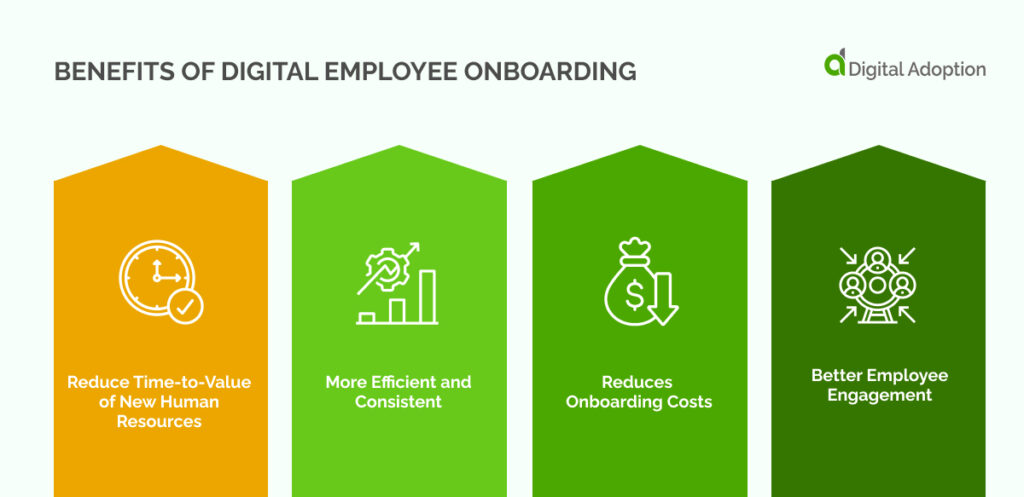
The benefits of digital employee onboarding range from holistic improvements to employee experience to financial benefits that directly impact your bottom line.
If you’re building a use case for the digital transformation of your onboarding process, this list of benefits might be a useful place to start:
Reduce Time-to-Value of New Human Resources
Digital onboarding reduces the time it takes to get new hires up and running, saving both money and time in the long run.
Hiring is an investment— you must first invest in your new employees and hope their productivity pays back that investment over time. It stands to reason that the sooner they can add value to your business, the better.
According to a survey by Glassdoor, 49 percent of employees who went through effective onboarding reported contributing to their team within the first week.
On top of that, a great onboarding experience increases the likelihood that new hires will stay longer, increasing employees’ lifetime value.
More Efficient and Consistent
With digital employee onboarding, you can be sure that your employees receive the same standard of training regardless of their location or background.
This is especially useful for franchises with multiple locations. Relying on existing employees to deliver a consistently high onboarding standard is a lot riskier than using the same digital learning tools regardless of location.
In a digital onboarding process, you can also automate steps like identity verification, account creation, and compliance tracking. Eliminating these mundane, finicky tasks helps avoid delays in the onboarding process.
Reduces Onboarding Costs
Another benefit of increased efficiency is reduced cost.
A digital employee onboarding process can help save on costs by eliminating the need for expensive manual labor.
By streamlining processes, digital onboarding reduces paperwork and administrative tasks associated with onboarding, which in turn leads to cost savings.
Better Employee Engagement
Digital employee onboarding provides a more engaging experience for both managers and new hires.
With digital tools such as videos, webinars, and online documentation, new hires can experience a faster onboarding process that is more engaging than traditional methods.
This helps to ensure that employees are motivated and engaged in their new roles from the very beginning.
Deliver the Perfect Onboarding Process with the 4 C’s of Onboarding
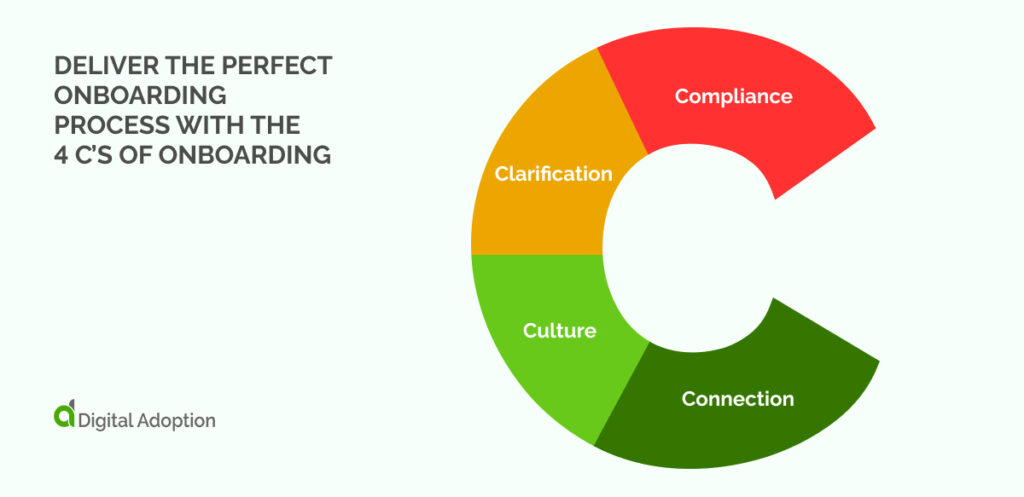
You now know all the theories behind digital onboarding and why it’s useful. Let’s shift to talking about some more practical advice that you can use to create your own digital employee onboarding process.
The 4 C’s is a handy mnemonic for ensuring your onboarding process ticks all the boxes and achieves everything it should achieve. They are:
- Compliance
- Clarification
- Culture
- Connection
Let’s expand on each of the 4 C’s and talk about why it’s critical to hit each note during onboarding:
Compliance
Above all else, setting clear expectations and ensuring compliance with relevant laws and regulations is paramount.
In the digital age, it’s easy to create a checklist of items that need to be completed in order for new hires to pass their onboarding process.
This could involve things like completing an employment agreement or submitting tax information.
Clarification
Once compliance matters are handled, it’s important to provide your new hires with a clear understanding of their position, the company’s mission and goals, and the tasks they will be expected to complete.
This can be done through videos or interactive training modules. But the best way to provide clarity to new hires is to assign them a mentor.
A mentor should be an experienced employee who answers any questions the new hire might have.
Culture
Onboarding is also a great opportunity to introduce your new team member to your organization’s culture.
This can include everything from highlighting core values, talking about the office dress code, and sharing information about perks and benefits.
This can help new hires quickly assimilate into their role and make an impact from day one. Be sensitive to the fact that new hires are often anxious to fit into existing company culture, and help them do so.
Connection
Finally, it’s important to emphasize connection when onboarding new hires.
Encouraging team members to connect with each other in meaningful ways can help build relationships between colleagues and create a more cohesive workforce.
This could take the form of regular (virtual) coffee breaks, where employees can get to know one another in an informal setting. Assigning a mentor is also a great way to build connections.
5 Practical Tips for Delivering Excellent Digital Onboarding
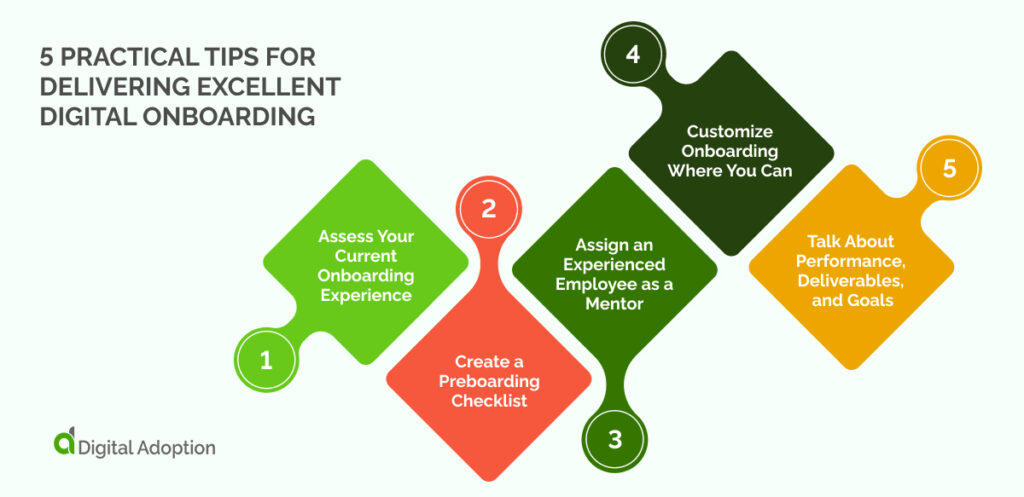
If you’re convinced of the benefits and are itching to create your own digital employee onboarding process, here are five practical tips to help you not only kick off the process but also set it up for prolonged success:
- Assess Your Current Onboarding Experience
Take the time to evaluate your current onboarding process and determine how it could be improved. Think about what might be missing or if there are any areas that need more clarity.
This is a great time to collect employee feedback on where they think the onboarding process could be improved.
Remember that when assessing employee experience, you must balance hard metrics with holistic opinions. You need to understand how your employees felt during their onboarding.
- Create a Preboarding Checklist
A preboarding checklist is a list of things to do before a new hire’s first day.
This checklist should include all the necessary steps for compliance, such as submitting tax information, completing an employment agreement, and providing any required documents.
It should also include account creation and ensuring the new hire has access to any and all systems they’ll need to do their job.
According to research by Enboarder, top companies are 53% more likely to have a preboarding process. Take a leaf out of their books.
- Assign an Experienced Employee as a Mentor
Having a mentor experienced in the organization’s culture, values, goals, and tasks can help new hires understand their role better and assimilate into the team faster.
This provides a range of benefits to the new employee but doesn’t end there.
Being a mentor to new hires is a great way to foster leadership skills in experienced employees.
- Customize Onboarding Where You Can
One of the pitfalls of creating a digital employee onboarding process is that it dehumanizes the process. It can make new hires feel like just another cog in the machine.
Make sure that the onboarding experience is tailored to each new hire. This could include personalized welcome messages, videos or interactive training modules, and even a digital tour of the office (if remote).
It’s easy to get lost in efficiencies and automation and forget that onboarding is an ultimately human experience.
- Talk About Performance, Deliverables, and Goals
Be clear about expectations from the outset and ensure that your new hires clearly understand what is expected of them.
Set useful goals for them. Temper your expectations about how productive a new hire can be, and communicate your expectations to them.
Provide guidance and support throughout their onboarding journey to set them up for success.
Digital Employee Onboarding: The Key to a Long and Fruitful Tenure
Digital Employee Onboarding helps you cut costs and get more value from new hires more quickly. And that’s great.
It’s also secondary to the real benefit of digital onboarding.
The real benefit is that digital employee onboarding enables new hires to get the most out of their first few days as possible. Both employers and employees want that, but employers continue to miss the mark.
With a little work, you can create a digital onboarding process that sets employees up for success and nails the first impression, setting them up for a long and fruitful career in your organization.

